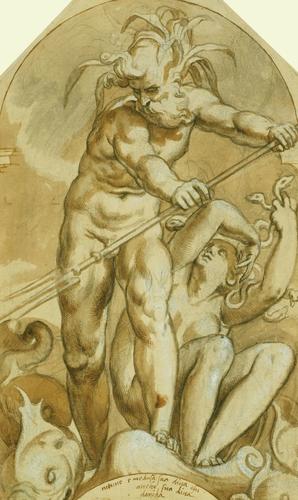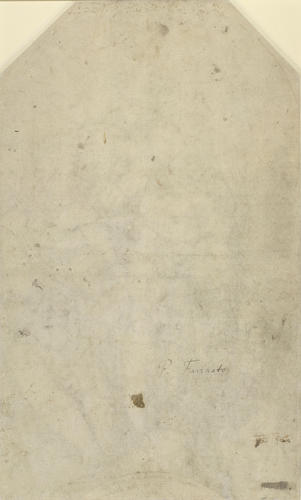-
1 of 253523 objects
Neptune and Medusa c. 1590
Black chalk, pen and ink, wash, white heightening, on buff paper | 42.2 x 25.6 cm (sheet of paper) | RCIN 905009
-
A drawing of the god Neptune and the gorgon Medusa. Neptune stands astride a chariot, holding a trident with both hands; Medusa crouches right, with arms above her head. Inscribed in the artist's hand, at lower edge: netuno e medusa sua diva efu anche sua diva dorida (‘Neptune and Medusa his mistress; Doris was also his mistress'). Inscribed on verso by William Gibson: P. Farinato.
The drawing is a study for a fresco in the Villa Nichesola-Conforti, Verona. The fresco forms part of a decorative cycle in three rooms of the villa carried out by Paolo Farinati and his sons around 1590. In addition to the frescoes showing mythological and classical scenes painted throughout the villa, Farinati painted illusionistic architectural devices, giving the villa the appearance of a peristyle. Farinati clearly considered the specific architectural details that would surround the present design, sketching an arch above the figures.
Neptune was a favourite subject of Farinati, appearing in several of his drawings and paintings, including RCINs 904992-3 and 904983. In Lisbon is an elaborated version of the present composition with sea-horses and tritons, where Neptune’s companion is his wife Amphitrite, but that drawing is not of sufficiently high quality to be by Farinati himself, but rather a pastiche by a follower of Farinati; another, still weaker version is in the Louvre, inv. 4900.
The large, clear and colourful drawings of Farinati were esteemed by seventeenth-century English collectors, and the Royal Collection now holds 47 sheets by Farinati and his followers. 14 of these bear an inscription in a hand identifiable as that of the dealer William Gibson, and it is probable that most, if not all, of the Farinatis were acquired during the reign of Charles II; the Kensington list of 1727 includes one volume entirely of drawings by Farinati, with others in a miscellaneous album. Of the 51 ex-Gibson drawings so far identified at Windsor, 14 have had their upper corners symmetrically cut, as here, and a further 29 sixteenth-century Italian drawings at Windsor have also been shaped in this way. This is a common feature among drawings that were in England in the late seventeenth century, though it is not known whether this was the favoured mounting style of one unidentified collector or a more general fashion.
Provenance
William Gibson; probably acquired by Charles II. Recorded in Inventory A, p. 117.
-
Creator(s)
Acquirer(s)
-
Medium and techniques
Black chalk, pen and ink, wash, white heightening, on buff paper
Measurements
42.2 x 25.6 cm (sheet of paper)
Other number(s)

